Boston Art Commission Youth Design and Public Art Application
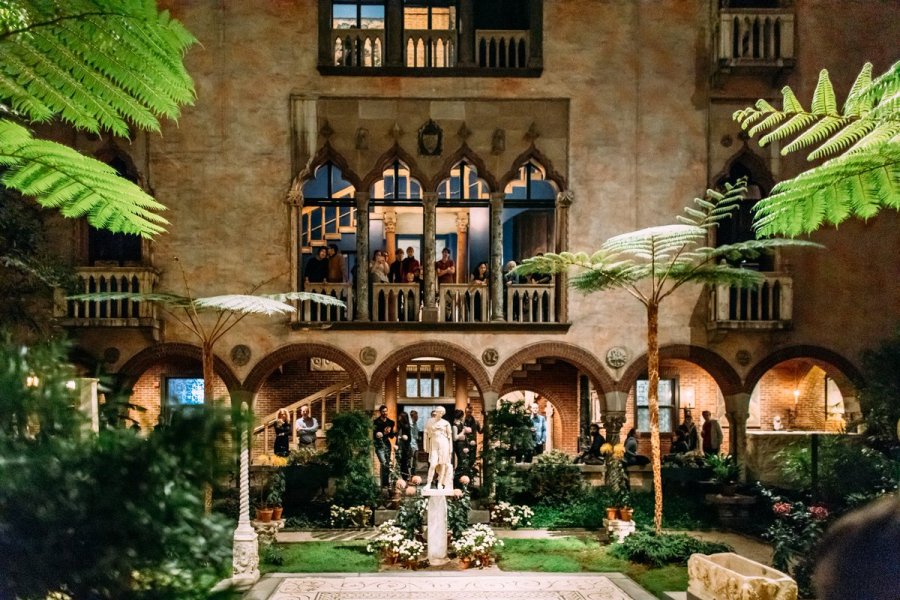
The biggest art theft in history occurred at the Isabella Gardner Stewart Museum, in Boston, Massachusetts. On March xviii, 1990, two burglars bankrupt into the museum and fabricated off with 13 works of art, worth half a billion dollars. Despite a thorough investigation and several promising leads, the Gardner theft remains unsolved to this 24-hour interval. While the details of the theft have been widely publicized, many folks don't know much well-nigh the history of the museum and the incredible woman who started it all.
Gardner established the pop art museum in Boston to hold her massive and valuable art collection. The museum is dwelling house to over 7,500 pieces of art, including paintings, furniture, silver, sculptures, textiles, ceramics and 1,500 rare books. The majority of the masterpieces came from ancient Rome, Medieval Europe, Renaissance Italy and Asia.
Let's take a look at the events that led to Gardner's love for art, the museum's beginnings and the largest art heist in history.
Stewart Gardner's Global Upbringing
Stewart Gardner was born in New York Urban center on Apr 14, 1840. Her father, David Stewart, made a living by importing Irish linen. Growing upward, she lived in University Place in Manhattan.
When she turned 16, Gardner moved to Paris with her family and completed her education abroad, allowing her to learn firsthand about Renaissance art. In 1858, the family moved back to New York. Shortly after, Gardner went to Boston to visit a former Paris classmate, Julia Gardner. Gardner introduced Stewart Gardner to her brother, John "Jack" Lowell Gardner Jr.
Despite her larger than life personality, Isabella was a piddling camera shy! In a letter to Edmund Colina, she wrote: "I am never photographed, unless by some Kodak fiend, who does it on the sly, & without my permission." pic.twitter.com/Nfm3bSElHU
— Gardner Museum (@gardnermuseum) November 25, 2018
Stewart Gardner's Marriage and Family Life
Jack Gardner was in the banking business and a member of Boston's upper class. Two years after Stewart Gardner met Jack Gardner in Boston, the ii decided to tie the knot.

On April ten, 1860, Stewart Gardner and Jack Gardner married at Grace Church building in New York Urban center. Stewart Gardner's begetter gifted the newlyweds a business firm at 152 Beacon Street in Boston. The Gardners started a life together in their new Boston abode, which was located on the Back Bay'south richest street. Presently after, the Gardner'due south had a son, John Lowell Gardner Iii, born June eighteen, 1863. The new parents nicknamed their son "Jackie."
Stewart Gardner'due south Travel to Heal A Broken Heart
In the mid-1860s, a serial of unfortunate events struck Stewart Gardner's life. Her son, Jackie, died from pneumonia at less than two years old in 1865. A yr later, Stewart Gardner suffered a near-fatal miscarriage and establish out she was unable to have more children. Around the same time, her sister-in-law and close friend, Julia Gardner, passed away.
The terrible news left Isabella Stewart Gardner heartbroken and depressed. On the advice of her physician, in 1876, the Gardners traveled to Paris, Scandinavia and Russia for a yr. During the trip, Stewart Gardner's health improved and she created scrapbooks of her adventures.
#OnThisDay in 1886, Henry James introduced Isabella to John Singer Sargent in London, where she visited his studio to view his infamous portrait, "Madame X." This introduction would pb to a long and storied friendship! Image: https://t.co/vis3ymRP2B pic.twitter.com/nI5SPlnkXX
— Gardner Museum (@gardnermuseum) Oct 28, 2018
A Passion For Collecting Fine art Emerges
Stewart Gardner'southward trip to Europe and Russia made her eager to run into the rest of the globe. In 1874, the Gardners traveled to the Heart East, Europe and Paris. The couple explored America, Europe and Asia in the late 1880s. During their adventures away, the couple gained an fifty-fifty greater knowledge of the arts and culture.
The Gardners started collecting art in Europe. When Stewart Gardner inherited $1.75 million from her father, she focused on growing her drove of European fine art. "The Concert" by Johannes Vermeer was 1 of her offset purchases. From Arab republic of egypt to the Far East, the Gardners collected paintings and statues from around the globe in the tardily 1890s. The Gardners also began obtaining tapestries, photographs, silver and manuscripts during their travels. Venice, Italy, became her favorite urban center to visit because artists frequently visited the Palazzo Barbaro, where the Gardners stayed. She became a regular at the palazzo, spending fourth dimension with the artists and purchasing art.
If information technology wasn't obvious enough past the Venetian-inspired Courtyard, Isabella had a real passion for Venice. Translated from Italian, she wrote, "The countryside comforts me but Venice is the only 1 who can make me happy. Oh blessed Venice I do not desire to ever exit y'all." pic.twitter.com/pQ0qQB6JHb
— Gardner Museum (@gardnermuseum) August 26, 2018
She Asked Male Associates to Purchase Art on Her Behalf
Stewart Gardner became known for her massive art drove, but many people didn't know that her male friends helped her larn some of her pieces. Art historian Bernard Berenson assisted her in acquiring nearly 70 pieces alone. In the 1890s, most fine art collectors were men; it was rare for women to collect art.
Fine art curator Christina Nielsen explained the auction process to WBUR, proverb, "She has a homo bid on her behalf. She sits in the back of the room, and she's got a handkerchief over her confront. Her principal competitors were the National Gallery in London and the Louvre that day. And they realized they were bidding against each other — and then they did a sort of gentlemanly bowing out. Meanwhile, her amanuensis swooped in and bought the moving-picture show and suddenly Isabella Stewart Gardner was a well-known name in the art world overnight."
Isabella had too much presence for only i name! She was oftentimes referred to in the Boston club pages as "Belle," "Donna Isabella," "Isabella of Boston," or "Mrs. Jack." pic.twitter.com/it3XqRZ1Fr
— Gardner Museum (@gardnermuseum) June 24, 2018
Isabella Built the Museum Later Her Married man'due south Death
By 1896, the Gardners discovered their enormous art collection barely fit in their Boston home. The couple dreamed of building a museum where they could go along their giant collection. However, Jack Gardner of a sudden died of a stroke in 1898.
After her married man's expiry, Stewart Gardner worked hard to make their dream come truthful. She bought a piece of land in the Fens of England and hired architect Willard T. Sears to draw up museum models inspired by Venice's Renaissance architecture. While Sears was in charge of constructing the museum, Stewart Gardner dictated the museum's design. When construction of the museum was completed in 1901, Gardner moved into the living quarters on the fourth floor and installed her collection throughout the museum portion of the building.
It's that time of the week! Every Thursday we're open up until 9 pm, then you dark owls tin experience the Gardner Museum under the stars. Bring a friend and bring together us this night for a Gardner getaway! ? movie.twitter.com/jr4xYAS7t5
— Gardner Museum (@gardnermuseum) March 29, 2018
The Museum's Artwork Was Deliberately Arranged to Build a Narrative
For a twelvemonth, Gardner carefully installed each of the items on the beginning three floors of the museum. Every piece was purposely assembled in different rooms to create a story. Gardner wanted to inspire others to autumn in dear with the art, rather than but learn about the fine art'southward history. Some pieces didn't fifty-fifty provide data near the painter or date of origin.
Gardner placed Titian'south masterpiece "The Rape of Europa" in the Titian Room. The Titian masterpiece sits above a modest piece of Stewart Gardner's stake green silk gown designed by Charles Frederick Worth. In the Dutch Room, Gardner organized famous works past European artists such every bit Peter Paul Rubens, Albrecht Dürer and Hans Holbein.
Isabella thought the painting on the right (Juana of Austria and a Immature Girl) was a Titian and therefore hung it in the Titian room. Although not by him, it was painted at the same time that his Europa painting arrived at the Spanish court. Image: https://t.co/T04XmHhax6 pic.twitter.com/SVPvRwsa11
— Gardner Museum (@gardnermuseum) April eighteen, 2018
The Museum's Other Items
Not only did the museum feature famous paintings, merely it besides presented rare books, manuscripts, furniture, tapestries, sculptures and decorative art pieces from the Gardner's travels. Many rooms displayed a mixture of these dissimilar pieces from various cultures and periods.
The Early on Italian Room highlights Italian Gothic and Renaissance fine art. These paintings are surrounded by article of furniture and other decorative manufactures from different periods and cultures across Europe, Egypt, the Centre East and Asia. The Dutch Room includes Italian, Dutch and English pieces such as an Italian nightstand, a Dutch sugar bowl and a Dutch common salt cellar.
Looking for a fashion to ease into the weekend? Stop by the Museum after work, we're open late on Thursdays! motion-picture show.twitter.com/Tn6DrBdQ3i
— Gardner Museum (@gardnermuseum) January 31, 2019
Artists Spent Time at the Museum
The chiliad opening of the museum was Jan. ane, 1903. Guests indulged in champagne and donuts while members of the Boston Symphony Orchestra performed. Scholar Charles Eliot Norton, philosopher William James, and symphony founder Henry Higginson attended the extravagant commemoration. On Feb. 23, 1903, she welcomed the public into the museum.
Stewart Gardner as well encouraged many artists, performers and scholars to visit the museum, such every bit John Vocaliser Sargent, Charles Martin Loeffler and Ruth St. Denis. Sargent used the museum'due south Gothic Room every bit a painting studio, while Loeffler posed as his model. Denis danced in the Cloisters, performing her signature piece, The Cobra. Stewart Gardner wanted the artists to detect inspiration from her beautiful collection and the museum's Venetian designs.
Hunt away those winter blues at the Gardner — we've planned a night of Caribbean area music, dance, and carnival costume-making for tonight's Tertiary Thursdays event: https://t.co/03h8Z7qJk5 motion-picture show.twitter.com/R31qYm4uUW
— Gardner Museum (@gardnermuseum) Jan 17, 2019
Standing Her Legacy
Stewart Gardner connected to abound her art collection and personally installed the pieces in the museum for the balance of her life. She passed away July 17, 1924, after suffering a series of strokes. Although Stewart Gardner was no longer living, she still dictated the museum'due south future.
According to her will, the museum must remain open "for the educational activity and enjoyment of the public forever." Information technology also specifies that aught in the museum can be sold, relocated or removed. The museum was to be maintained the way she left it, pregnant new pieces weren't allowed either. The collection remained untouched until March 18, 1990 — after 13 pieces valued at $500 one thousand thousand were stolen.
#FunFact: The vibrant red walls of the second floor'due south Raphael Room come from not one damask, but rather a patchwork of boldly-patterned fragments sewn together and stretched across the walls. During your side by side visit, run across if you tin see the variations! moving-picture show.twitter.com/tUouhw70UJ
— Gardner Museum (@gardnermuseum) December 5, 2018
Suspects Arrived in Fake Law Uniforms
As Bostonians celebrated St. Patrick's Day during the early hours of March 18, 1990, two thieves sat inside a red Dodge Daytona on Palace Road nearly the Isabella Stewart Gardner Museum. The ii men were disguised every bit police officers and 1 of them had on a fake wax mustache.

For almost an 60 minutes, the ii criminals waited in their motorcar to avoid the St. Patrick'south Day party goers. As the oversupply dispersed, the two thieves began their elaborate plan. They exited their vehicle, walked to the archway of the museum and pressed the buzzer virtually the door at 1:24 a.k.
A Museum Security Baby-sit Allow the Thieves In
The museum had two security guards on duty that dark. Afterwards the first guard, Richard Abath, patrolled the museum, he came back to the front desk to modify positions with the other guard. Abath heard the buzzer and saw two men outside. They told Abath they were police officers who had heard a commotion in the museum's courtyard, and asked to enter the building.

Although Abath knew that guards weren't allowed to open the door to uninvited guests, he wasn't certain if the protocol also applied to police force officers. Abath believed the men considering of their uniforms. While the other guard patrolled the galleries, Abath allowed the disguised men to enter.
Handcuffed and Tied
The thieves walked to the front end desk, where Abath was stationed. One of the intruders told Abath his face up seemed familiar and that there was a warrant for his arrest. Abath, dislocated, left the front end desk-bound area, where the just alarm push was located. The thieves immediately forced Abath to face the wall and handcuffed him. Abath thought the abort was a mistake, but quickly noticed the intruders didn't search him earlier putting him in handcuffs. He also realized one of the thieves wore a fake mustache.

A few minutes later, Abath'due south partner returned to the forepart desk and the thieves handcuffed him, likewise. The thieves then revealed they came to rob the museum. The robbers took the guards to the basement, where they handcuffed them to pipes and wrapped their heads, easily, and feet with duct tape. The criminals moved on to the galleries to start their heist.
81 Minutes to Consummate the Largest Theft in History
The museum's motility detectors recorded the thieves' movements. First, the robbers entered the Dutch Room and approached Rembrandt'southward "Self-Portrait," but the local alarm went off. The thieves smashed the alarm. Later taking the "Self-Portrait" off the wall, the two men unsuccessfully tried to remove the painting from its wooden panel. They left the painting on the flooring instead.
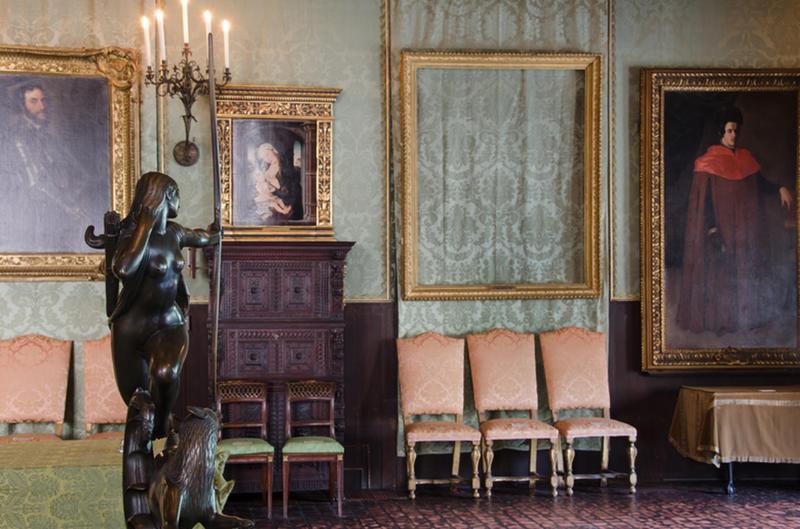
The thieves went on to cut Rembrandt'due south "Christ in the Tempest on the Sea of Galilee" and "A Lady and Gentleman in Blackness" from the frames. Next, they took Vermeer'due south "The Concert" and Govaert Flinck'south "Landscape with an Obelisk." The criminals stole a full of 13 pieces throughout the museum including a Chinese Statuary Gu, 5 Degas drawings, and an hawkeye finial. The robbery occurred in 81 minutes. At eight:fifteen a.m., police arrived at the scene and found the guards tied upward in the basement.
The FBI Found No Motive or Pattern
Believing that the stolen pieces would cantankerous land lines, the FBI quickly took over the case. The FBI thought the perpetrators were part of a criminal organization from the mid-Atlantic and New England. Throughout the investigation, the FBI held hundreds of interviews including with American drug lords and erstwhile museum guards.
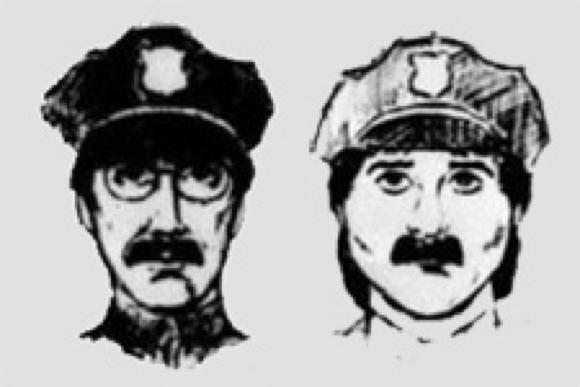
In addition, the FBI worked with many specialists, including top private investigators, Japanese and French authorities, museum directors and fine art dealers. Although the FBI nerveless over a thousand pages of evidence, the investigation uncovered no single motive or blueprint. The FBI agent in accuse of the Stewart Gardner case, Geoffrey J. Kelly, has mentioned that the FBI knew the identities of the criminals, but Kelly didn't say if the suspects remained dead or alive. Kelly has provided no further comment on the identities.
A Few Theories Almost the Art Heist Have Surfaced
1 theory investigated by the FBI was that the heist was planned and carried out by the Irish Republican Army, with the goal of eventually leveraging information to release their members from prison house. A different theory suggested Boston's top crime boss, Whitey Bulgar, organized the robbery. The FBI also had a theory that Myles J. Connor Jr. bundled the criminal offense before he became New England'southward peak art thief.
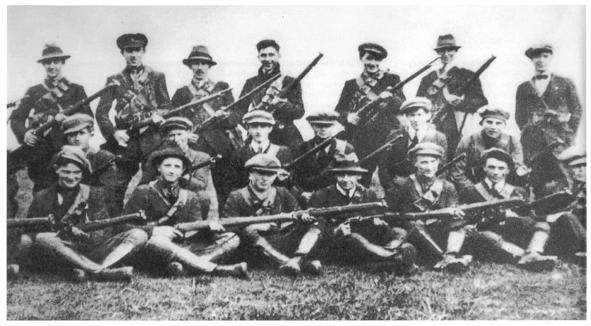
In 2009, the Stewart Gardner Museum'due south director of security, Anthony Amore, heard a strange rumor. Amore said, "One bizarre theory was from people who say Mrs. Gardner speaks to them and tells them who stole the paintings. Also, others say mythical figures have spoken to them about the thefts."
One of the Master Suspects Was Boston Gangster Robert Donati
Boston gangster Robert "Bobby" Donati became the FBI's top suspect during the investigation. In 1997, Connor claimed Donati was his accomplice in organizing the Gardner robbery. Connor and Donati visited the museum together a few times before the theft. As well earlier the robbery, Donati went to a nightclub called The Shack, where he was seen carrying a handbag of police uniforms.
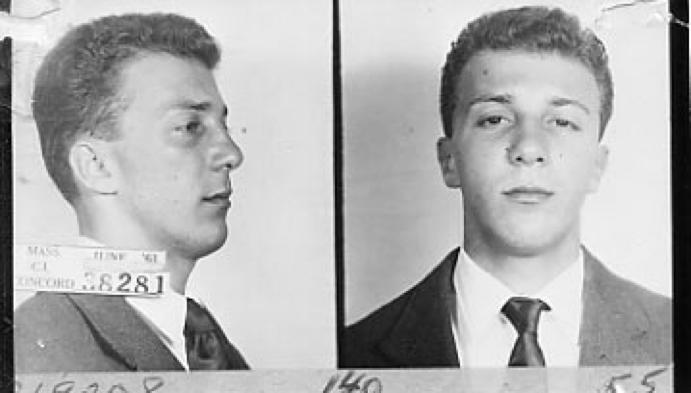
During the 1990 robbery, Connor remained in prison, only he said Donati managed the heist. In 1991, Donati was murdered. According to the New York Daily News, he may accept been a victim in a gang war. The FBI somewhen threw out Donati as a pb suspect.
Another Principal Suspect Was Robert "Bobby the Cook" Gentile
Gangster Robert "Bobby the Cook" Gentile was also on the FBI'due south radar as a possible doubtable. The FBI believed he held some of the paintings from the Gardner Museum heist. In 2012, the FBI raided his home in Manchester, Connecticut, after the FBI brought drug charges against Gentile. The FBI establish nothing in the raid except for a list of how much each stolen piece would cost on the blackness market. Yet, Gentile said he was innocent and knew zip about the robbery.
Later in 2016, the FBI filed gun charges confronting Gentile to force him to talk about the location of the stolen fine art pieces. The federal prosecutor, John H. Durham, claimed Gentile and his mob partner Robert Guarente attempted to return 2 stolen artworks to reduce a prison house sentence for one of Guarente's assembly. Too, Guarente'south married woman insisted Gentile possessed a few of the stolen paintings. Gentile's lawyer argued against these claims and said that Gentile didn't know anything about the heist. In 2018, Gentile was sentenced to 54 months in prison house on gun charges, but still hasn't admitted to whatever cognition almost the whereabouts of the paintings.
Robert Gentile, the Hartford gangster who may hold the clue to solving the globe's richest fine art heist, is scheduled to be released from prison Sunday https://t.co/e8DpgiQWS1 picture.twitter.com/4lhci3nCdZ
— Hartford Courant (@hartfordcourant) March xi, 2019
A Few Leads Included a Alphabetic character and a New Video
In 1994, museum managing director Anne Hawley received a letter that bodacious the return of the stolen pieces for $2.6 million. The letter author demanded that the museum get The Boston Globe to impress a coded message in the business concern department. Although the paper published the bulletin, the mysterious writer disappeared after learning police force enforcement were involved.

On Aug. vi, 2015, the U.Due south. Chaser's Office released a video that was taped the night before the heist at the Gardner Museum. On the half-dozen-infinitesimal video, two men appear at the entrance of the museum. One homo was identified as Abath, the security guard who was tied upward during the robbery. The other man remains unknown. Authorities have asked for the public's help to identify him in the footage. The video shows Abath buzzing the unidentified man into the museum twice. The man stayed in the foyer for a couple of minutes, exited and left in a car.
Deoxyribonucleic acid Collected at The Crime Scene Went Missing
Afterwards the robbery in 1990, constabulary collected traces of Dna from the duct tape and handcuffs that the thieves used to agree the museum's security guards. In 2010, the FBI wanted to retest the testify due to recent improvements in DNA analysis, hoping the new test would help discover the thieves. Notwithstanding, the prove containing the Deoxyribonucleic acid had disappeared.

The FBI conducted a search for the criminal offence scene evidence, simply it was nowhere to be institute. Investigators don't know when the evidence went missing, only bearding sources claimed the evidence had been gone for over a decade. The FBI as well doesn't know if the items were misplaced, stolen or disposed of. The missing evidence became some other setback for the Stewart Gardner case, which remains unsolved to this twenty-four hour period.
A True-Offense Podcast Investigated the Unsolved Art Heist Mystery
In 2018, WBUR, a public radio station, collaborated with The Boston World to produce a 10-part podcast covering the fine art heist mystery. The podcast, "Terminal Seen," covers the robbery, the suspects, people connected to the case and the FBI's investigation.
The squad, led past WBUR members Kelly Horan and Jack Rodolico, researched the mystery for a year. The podcast features many interviews, including one with security guard Abath and his partner from the nighttime of the crime. The museum's director of security, Affection, says, "Things like this podcast that can reach a large audience are important for keeping the story alive in people's minds and reminding the public that we're never going to finish looking for the stolen fine art."
Where are the Rembrandts? Listen to Last Seen on @stitcher today: https://t.co/5rTJ2QVtXt pic.twitter.com/94IoyyB3DT
— Last Seen Podcast (@LastSeenPodcast) September 18, 2018
A Documentary and Book Roofing the Offense Was Released
In 2005, a documentary motion-picture show called "Stolen" by Rebecca Dreyfus featured the famous heist. The documentary follows fine art detective, Harold Smith, as he looks into the robbery's investigation and the 13 seized pieces. Smith chats with contemporary authors almost Stewart Gardner's reputation every bit a famous art connoisseur and the works of Dutch painter Vermeer.
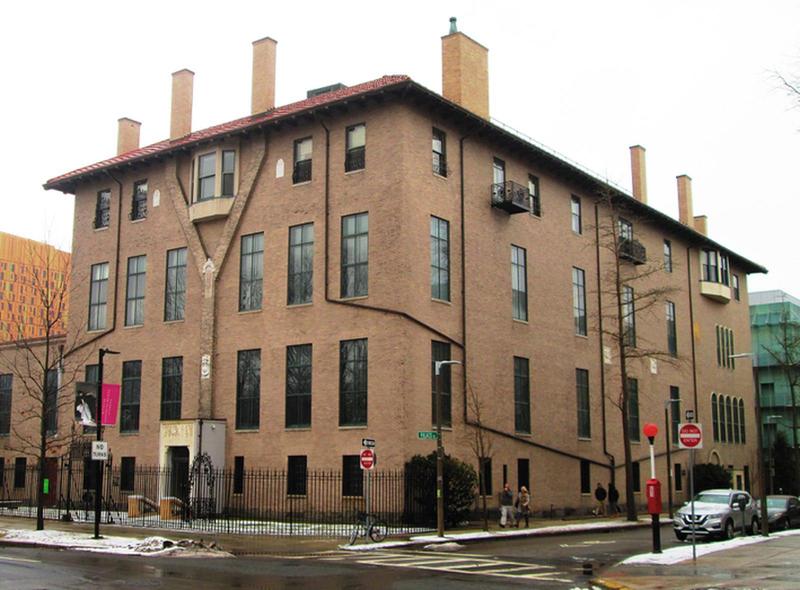
The Isabella Stewart Gardner Museum printed a pictorial book also named "Stolen" in 2018. "Stolen" provides data about the 13 stolen works of art and contains essays from key staff members including Amore and Nielsen. Museum guests frequently ask for more than details on the missing pieces, which inspired the museum to produce "Stolen."
The Famous Heist Is Mentioned Throughout Pop Culture
Many Tv shows have featured the criminal offence, including "The Black List," "The Simpsons" and "Drunk History." In "The Black Listing," the episode "The Courier" features a criminal named Raymond Reddington looking at Rembrandt's painting "Christ in The Tempest on the Body of water of Galilee."
"The Simpsons" has an episode in which Mr. Burns possesses stolen art from the Stewart Gardner Museum at Burns Manor. As a result, the constabulary abort Mr. Burns and throw him in prison. In "Drunk History," the episode "Boston" features 2 criminals struggling to steal fine art and doing whatever they tin can to complete the heist.
New Simpsons tonight with @realGDT.Who'south YOUR favorite invitee star? #TheSimpsons pic.twitter.com/lT7H9fjYjl
— The Simpsons (@TheSimpsons) March three, 2019
Some of the Stolen Paintings
Govaert Flinck's "Landscape with an Obelisk" from 1638 is one of the stolen works of art. The robbers took Flinck'southward painting from the museum'due south Dutch Room. Many art enthusiasts initially believed the picture belonged to the painter Rembrandt, only they later on learned Flinck was the owner. Dutch painter Flinck was actually a educatee of Rembrandt, who helped influence his piece of work.
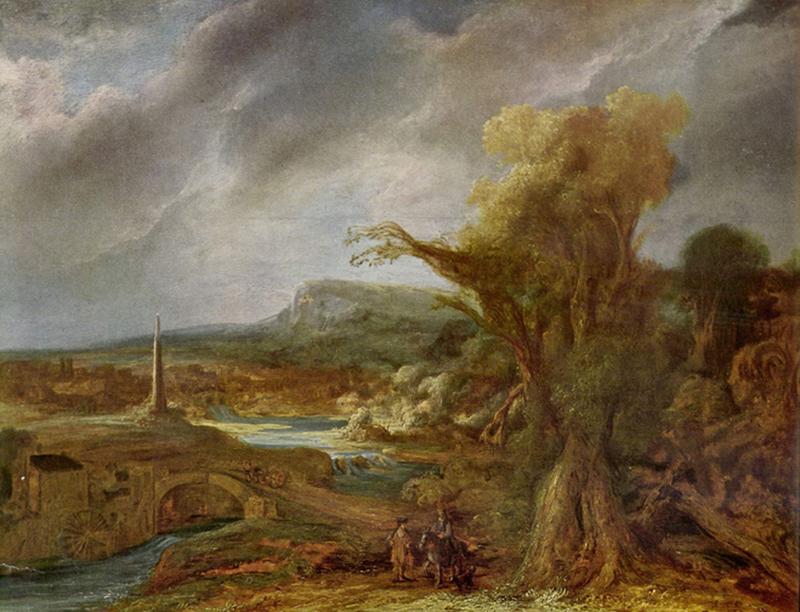
Flinck created "Landscape with an Obelisk" using oil on woods. The beautiful painting features a stormy day, a fantasy landscape and an obelisk inspired by one that's near Amsterdam. The picture also includes a bridge and a pocket-sized human on a horse.
The Painting "Chez Tortoni" Was Another Missing Piece
Some other missing painting is Édouard Manet'due south "Chez Tortoni" from around 1875. The museum's Bluish Room used to hold Manet'south famous artwork. Manet was known to create paintings in cafes that resembled snapshots.
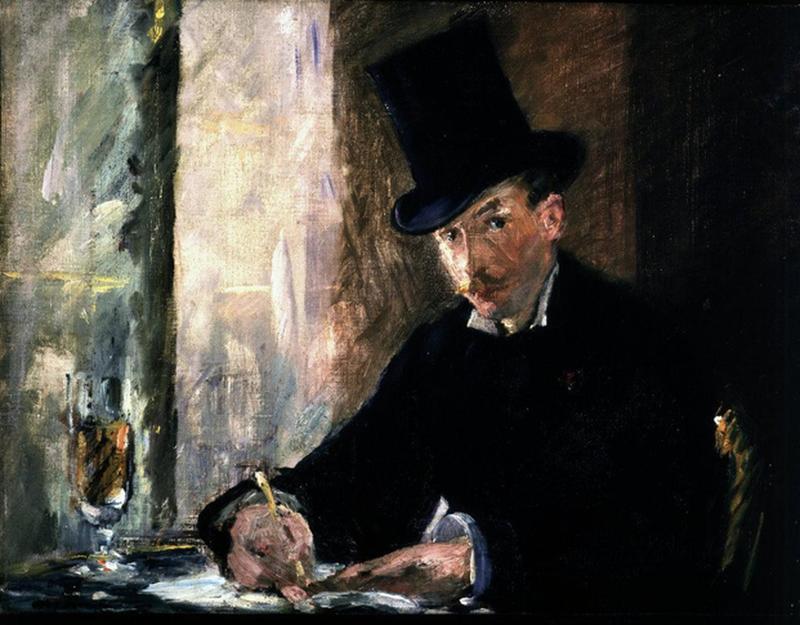
Manet's painting illustrates a immature man with a mustache and a height hat sitting in the Café Tortoni de Paris. The human is holding a pencil in his paw and writing on paper. The man'southward optics are positioned looking directly at the slice's viewer. Additionally, a glass of wine sits on the gentleman's table. WBUR describes the picture'southward brush strokes every bit broad and tactile.
"La Sortie de Pesage" and "Three Mounted Jockeys" past Degas Were Stolen
Several Edgar Degas works disappeared in the heist, including "La Sortie de Pesage" and "3 Mounted Jockeys." These two paintings used to hang in the museum'south Brusk Gallery. Degas, a French artist, was popular for drawing dancers, simply in "La Sortie de Pesage" he illustrated a crowd of people, a jockey and a equus caballus using pencil and watercolor. No one knows when Degas created "La Sortie de Pesage."
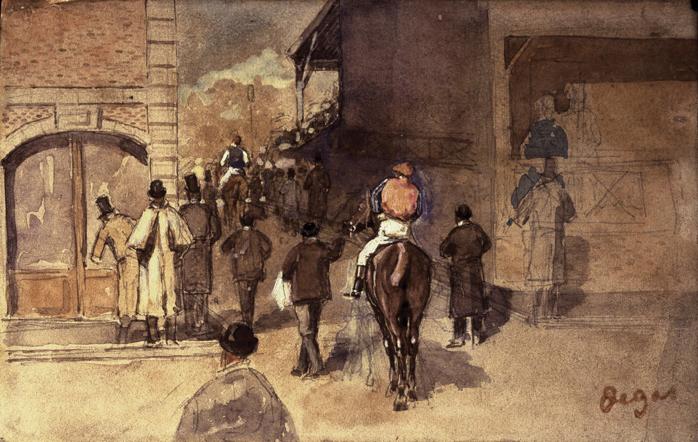
The thieves too stole the Degas painting "3 Mounted Jockeys" from around 1885. Degas created the piece with black ink and oil pigments. While one jockey sits upright on a horse, the other 2 jockeys are upside down in the painting.
"Program for an Artistic Soirée" 1 and Ii Were Taken
A couple more Degas works that vanished include "Program for an Artistic Soirée" and "Program for an Artistic Soirée, Report ii" from 1884. The criminals removed these Degas drawings from the Brusque Gallery'due south cabinets. Stewart Gardner had assembled the cabinets herself to showcase the artwork.
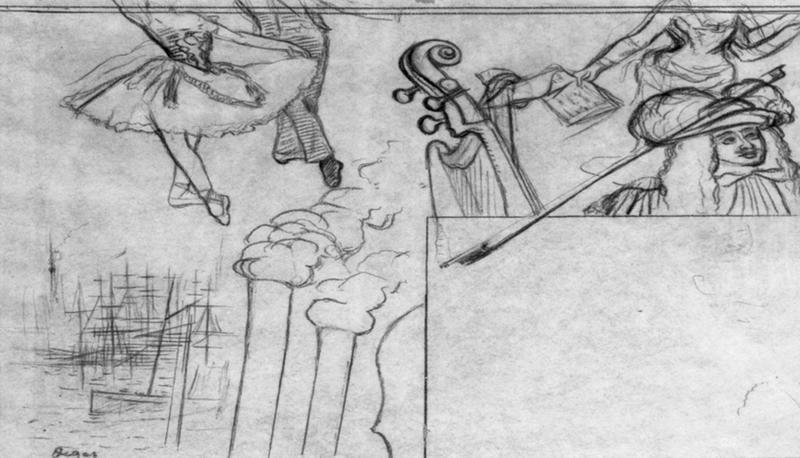
Degas sketched the drawings with charcoal on white paper, which features the skirt and legs of a dancer. The drawing likewise includes a adult female holding an open up booklet and a man in a hat and wig next to a musical instrument. The second "Program for an Artistic Soiree" appears more finished than the first sketch.
"Cortège aux Surround de Florence" and a Few Works Past Rembrandt
Yet another Degas, the sketch "Cortege aux Environs de Florence" and a few Rembrandt works were also stolen. "Cortege aux Environs de Florence" used to be displayed in the Short Gallery. Degas drew the artwork with a pencil and used a sepia wash on paper. The sketch illustrates a carriage with horses, a woman with a giant umbrella and three women who may be dancing. He finished this sketch effectually 1857.
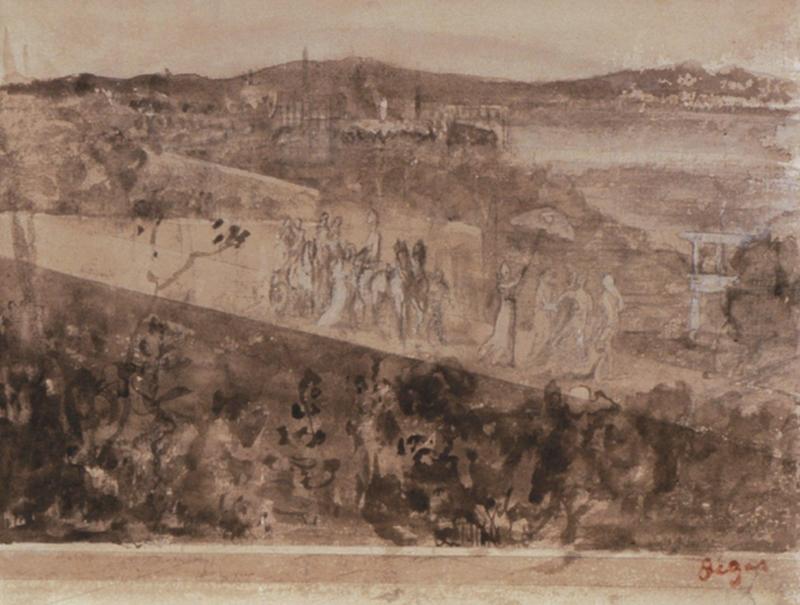
Other missing works include Rembrandt's "A Lady And Admirer In Black" and his most famous painting "Christ In The Storm On The Sea Of Galilee" from 1633. The criminals stole both paintings from the museum'south Dutch Room. The thieves besides made off with his tiny sketch titled "Portrait Of The Creative person As A Young Human being" from 1633. The sketch features Rembrandt's serious face up with untidy pilus. The thieves attempted to seize Rembrandt'south "Self-Portrait" oil painting, but the job was unsuccessful.
The Thieves Also Took a Gu, a Finial and Vermeer'south "The Concert"
From the museum's Dutch Room, the criminals fabricated off with a Chinese Gu (a bronze chalice) from 12th century BC. According to WBUR, the Gu was one of the most elegant and oldest pieces in the museum. Another item removed from the museum was the statuary French Eagle finial from around 1813. The eagle was attached to a flagpole from Napoleon's Beginning Regiment of Imperial Guard. Although the hawkeye is gone, the flag remains in the museum.
WBUR reports that Vermeer'due south "The Concert" is the rarest and nigh valuable of the stolen works because few of his paintings exist. Vermeer'southward painting is priced at $200 million. "The Concert" features three musicians surrounding a piano and a black-and-white tiled floor.
Fearful until the final moments of #LastSeen that I was hearing the securely eerie soundtrack for the last fourth dimension…until the words "more episodes" were uttered. Safe to say, though, that @kellyahoran is not a fan of the missing Bronze Eagle Finial. https://t.co/0OQxQIDaAG #podcast pic.twitter.com/r4a7EaXSuf
— Jann Alexander (@AustinDetails) November 19, 2018
The Museum and FBI Are Still Looking for New Leads
Although the Gardner instance collected some promising leads, the identities of the criminals and the whereabouts of the thirteen pieces remain a mystery. To this day, empty frames of the missing paintings hang on the walls. The Isabella Stewart Gardner Museum hopes that the stolen pieces will one twenty-four hour period be returned. Currently, the museum is offering a $ten 1000000 reward for information that can help recover the stolen pieces.

The FBI, the museum and the U.S. attorney's role continue to search for new leads. The museum encourages anyone with information to reach out to the Stewart Gardner Museum. The museum's managing director says "I've spent more than a decade preparing for any scenario. I'm very ready. I'll go anywhere. I'll meet with the devil for these paintings."
Source: https://www.ask.com/culture/isabella-stewart-gardner-museum-art-heist-mystery?utm_content=params%3Ao%3D740004%26ad%3DdirN%26qo%3DserpIndex
0 Response to "Boston Art Commission Youth Design and Public Art Application"
Post a Comment